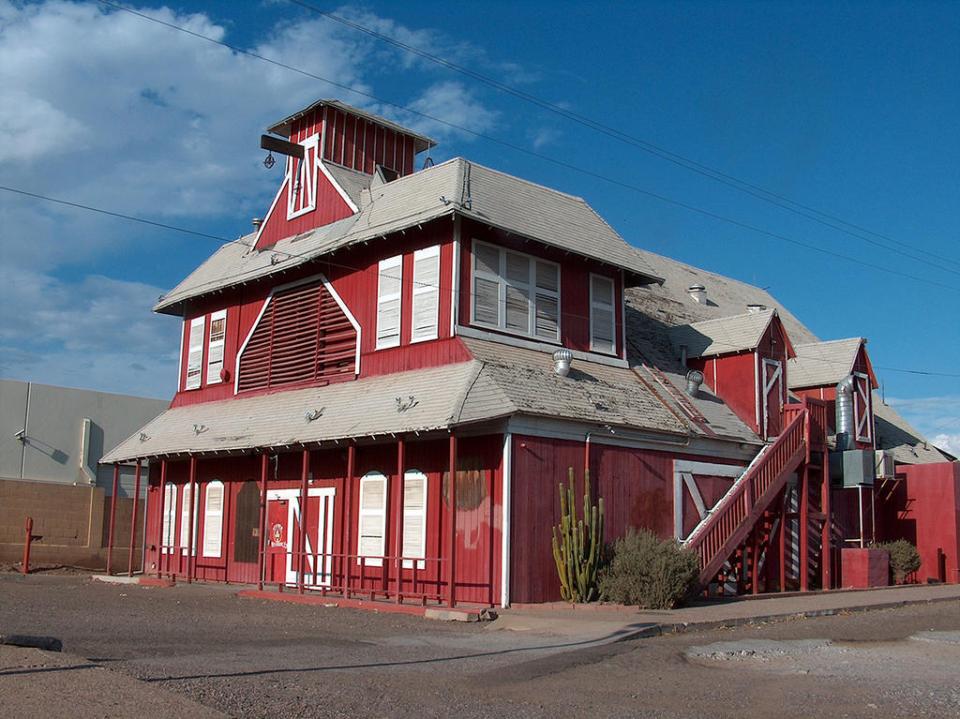69 Cent Shots and Postmodern Clutter in the Big Red Barn
A Fond Eulogy to Tempe’s Minder Binders
Editors' Note: Author Larry Ellis is an alum of the Department of English (BA 1975; MA 1997; PhD 2003).
On Tchoupitoulas Street, just upriver from the Greater New Orleans Bridge, stands the celebrated Float Den of Louisiana carnival artist Blaine Kern. Here, neat rows of moonfaces and sylphs, pirates and jolly alligators, leering jesters and lounging gorillas await placement on the hundreds of floats that will roll through the streets of the city in the grand chaos that is Mardi Gras.
Now imagine that the Lord of Misrule takes a notion to uproot Kern’s vast warehouse, shake it violently, and then return it to its foundations in the Mississippi mud. If you dare, take a gander within and revel in a catawampus splendor that invites your reconsideration of the very rules of balance and proper juxtaposition. You might see the Float Den’s opulent props hovering like helicopters on maneuver as they hang suspended from the trussed beams that support the ceiling. And on the floor, a higgledy-piggledy topography fashioned from whatever does not stick to the rafters. Such corrections would be natural, for regimentation and geometry have no place in the trickster-realm of Carnival.
If you attended ASU between 1972 and 2006, this is what you would have experienced in Tempe’s now-defunct watering hole, Minder Binders. Named after trickster-capitalist Milo Minderbinder of Joseph Heller’s Catch-22, the Big Red Barn on McClintock just north of University dared to defy Tempe’s emerging obsession with imposing order on the idiosyncratic. Its eclectic interior, a confused bricolage of statuary and bric-a-brac great and small, surreal collages, signs and posters of every description, and a collection of ready-mades that would confound Marcel Duchamp, challenged the master narrative of corporate urban renewal that lurked beyond its doors.
Minder Binders’ interior was divided into dark rooms and an upstairs loft, their ceilings effectively lowered by the suspension of scores of artifacts and oddities. From one hung a full-sized Umiak whaling boat, from another a statue of a boar-headed man in a yellow t-shirt. Above the stairway to the loft, a stuffed alligator—and dangling from the ceiling of another room a buckboard wagon and the upside-down chassis of a vintage automobile. On the wall, the head of Paul Bunyan cast a glaring eye on whoever should pass, and standing nearby, a red British telephone booth stood below an exit sign where there was no exit at all. Other signs pointing to the restrooms pointed in the wrong direction. Spaces that weren’t crammed tight with one curiosity or another were painted in whimsical designs.
The booths reflected the tavern aesthetic of the early 1970s: dark wooden planks coated in polyurethane formed benches and tables, the latter inscribed with signature and graffiti, the former bearing the names of cities printed on their backs in large block letters. Old hands were ever wary of sitting in the booth that adjoined the restroom, for its poorly joined wall had little effect in protecting patrons from a fragrance unmatched until the heyday of the Men’s Room in Mill Avenue’s Long Wong’s.
A barrel at the end of one of the bars was brim-full with unshelled peanuts (a deception, for it sported a false bottom several feet below the top rim). When it approached empty, the bartender would untie a halyard and lower a chute rigged to an array of antique block and tackle, excessive to the task and sturdy enough to raise the mainyard of the U.S.S. Constitution. When the top of the chute connected with a bin painted like an elephant’s head, its bottom emptied a dusty stream of goober peas into the barrel as if it were the trunk of that same elephant. On many an evening, it was there that I would plant myself to munch on free peanuts and imbibe 69 cent shots—small shots, to be sure—of what were then high-end liquors. Beer was even cheaper.
On busy nights, the crunch of peanut shells on the floor was accompanied by audio mixes as surreal as the décor. The music of the day (Rod Stewart, John Prine, Jerry Jeff Walker, The Moody Blues) and of days past (a selection from the musical Damn Yankees comes to mind) were pasted together with fragments of Firesign Theater, Monty Python’s Flying Circus, Tom Lehrer, and esoterica of all stripes. The effect of a weekend evening at Minder Binders was at once claustrophobic and exhilarating, a full immersion baptism in the waters of Dada and a descent into weirdness that would today be the envy of either Portland or Austin.
Minder Binders was a snug harbor for the liminal ambiguities of the carnivalesque in a metropolis that eschewed the merry uncertainty of carnival space. When the Big Red Barn was finally torn down, a noble but short-lived attempt was made to reconstruct its interior in a new building near the original site. What remained of its vast store of memorabilia was sold in auction in 2017. Yet, world mythology tells us that the trickster never dies, nor does he fade away. We may take comfort in the certainty that the seeds of trickster discourse are even now germinating in these fragments, awaiting rebirth in new venues congenial to the peculiar.
Image 1: The Big Red Barn exterior of Minder Binders before its demolition and reimagining into faux Spanish Mission style in 2013. Photo by AZ-3D on DeviantArt.
Image 2: The iconic telephone booth sits among other eclectic memorabilia in the former Minder Binders in this 2017 photo from The Arizona Republic by Sue Kern-Fleischer.


